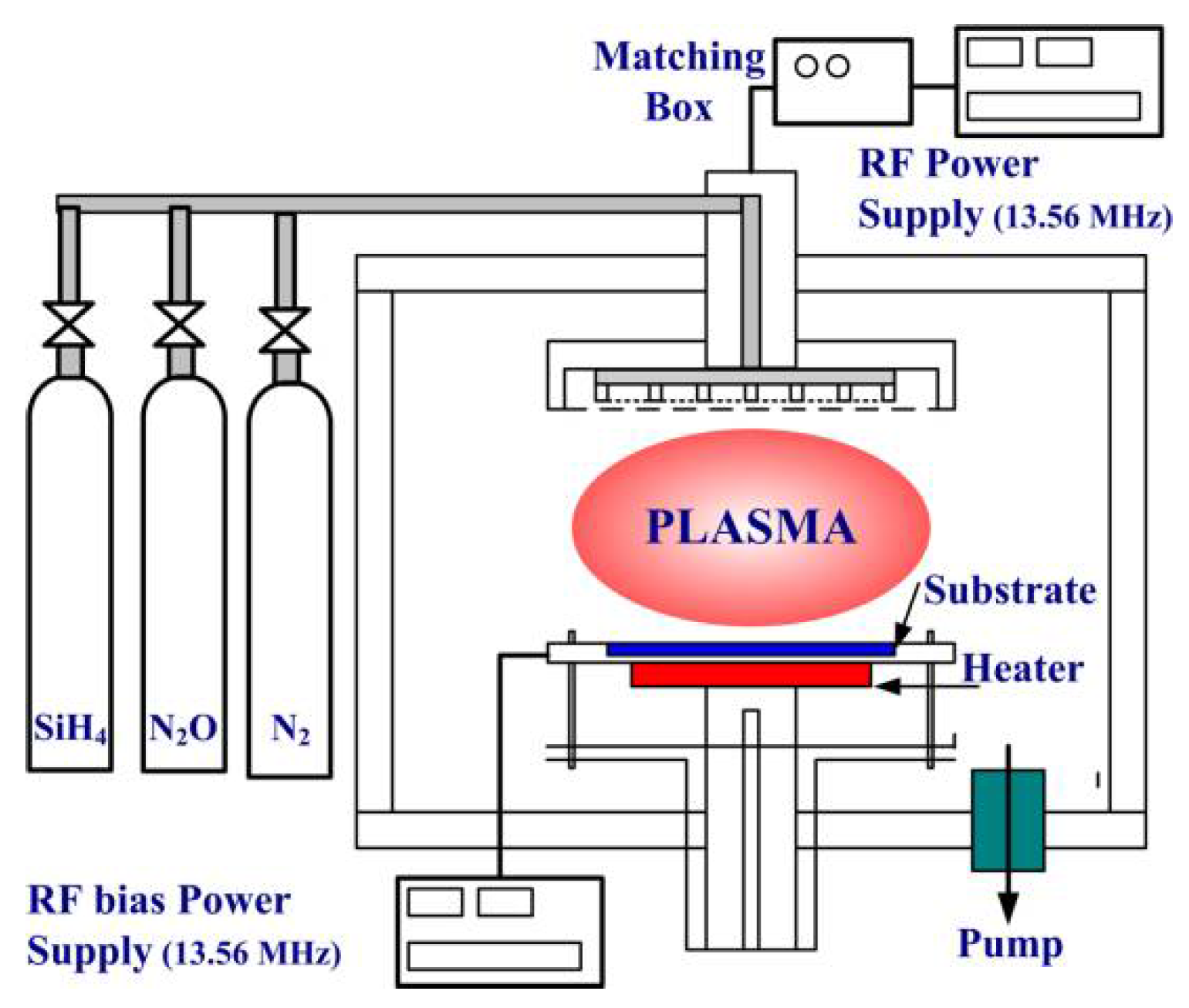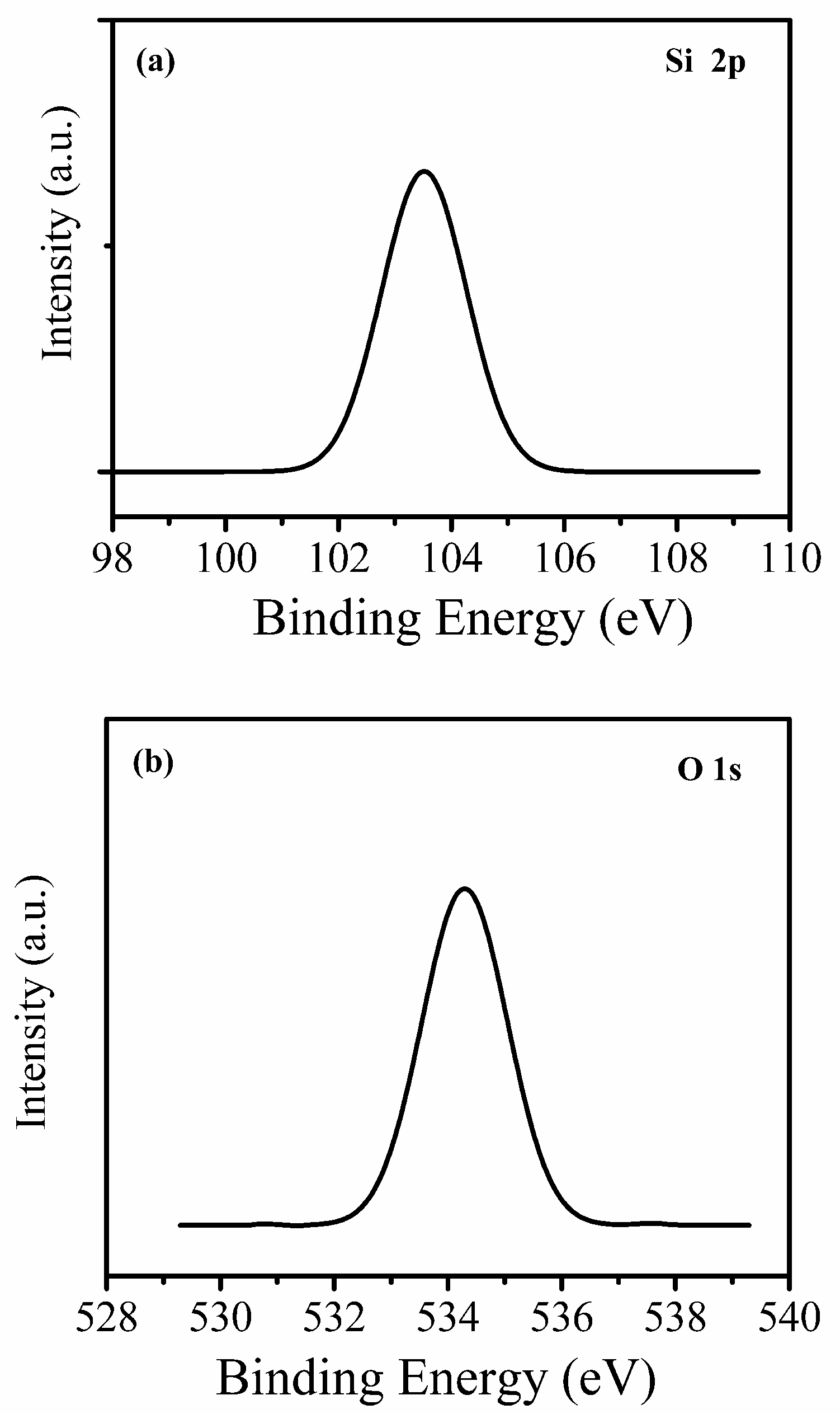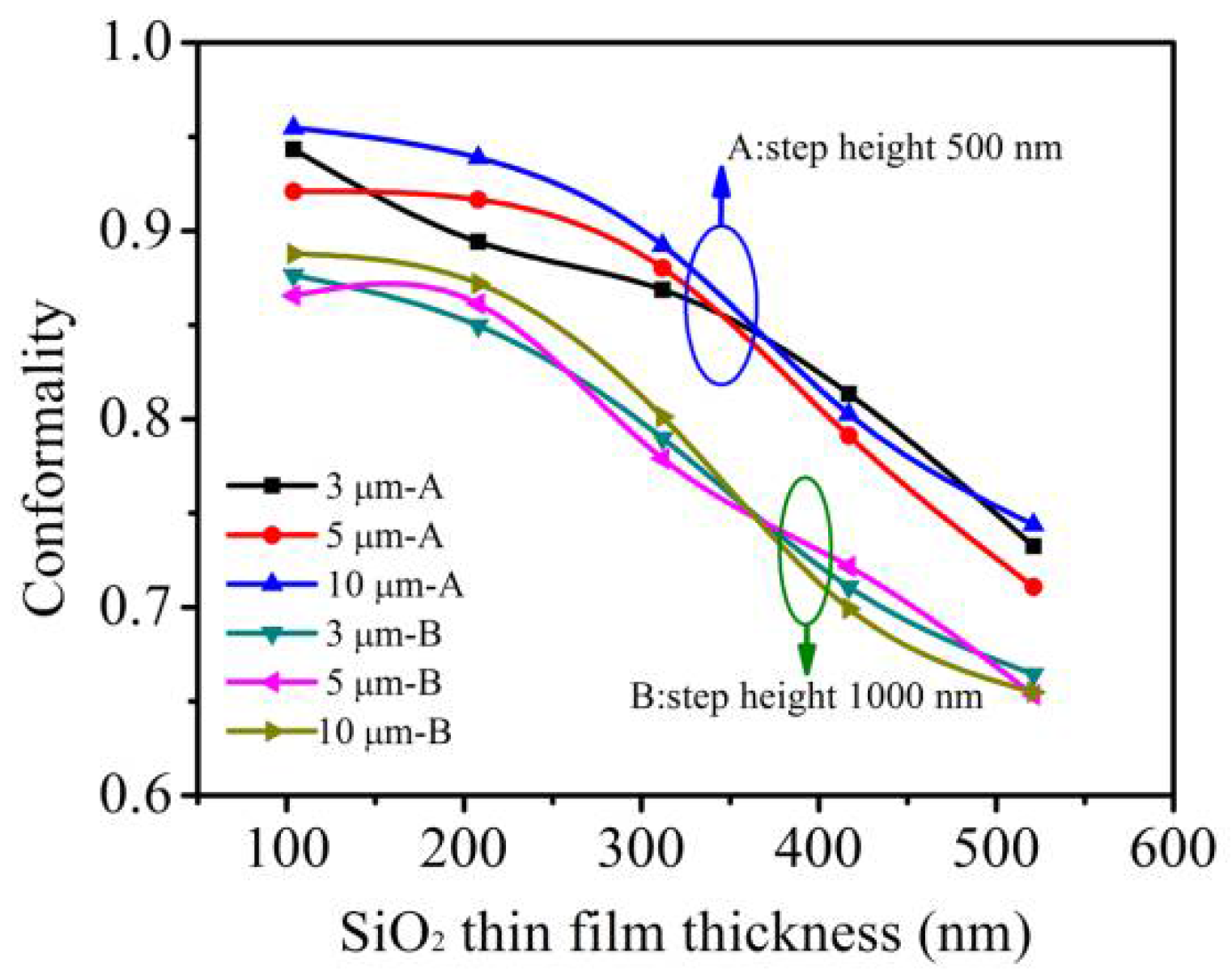Optical Constant and Conformality Analysis of SiO2 Thin Films Deposited on Linear Array Microstructure Substrate by PECVD
Abstract
:1. Introduction
2. Analysis Methods
3. Experimental Details
4. Results and Discussion
5. Conclusions
Author Contributions
Funding
Institutional Review Board Statement
Informed Consent Statement
Data Availability Statement
Conflicts of Interest
References
- Nam, T.; Lee, H.; Choi, T.; Seo, S.; Yoon, C.M.; Choi, Y.; Jeong, H.; Lingam, H.K.; Chitturi, V.R.; Korolev, A.; et al. Low-temperature, high-growth-rate ALD of SiO2 using aminodisilane precursor. Appl. Surf. Sci. 2019, 485, 381–390. [Google Scholar] [CrossRef]
- Wang, L.; Jiang, Y.; Jiang, C.; Liu, H.; Ji, Y.; Zhang, F.; Fan, R.; Chen, D. Effect of oxygen flow rate on microstructure properties of SiO2 thin films prepared by ion beam sputtering. J. Non-Cryst. Solids 2018, 482, 203–207. [Google Scholar] [CrossRef]
- Liu, H.; Wang, L.; Jiang, Y.; Li, S.; Liu, D.; Ji, Y.; Zhang, F.; Chen, D. Study on SiO2 thin film modified by post hot isostatic pressing. Vacuum 2018, 148, 258–264. [Google Scholar] [CrossRef]
- Gignac, L.; Parrill, T.; Chandrashekhar, G. Porous SiO2 films analyzed by transmission electron microscopy. Thin Solid Films 1995, 261, 59–63. [Google Scholar] [CrossRef]
- Choi, D.; Kim, B.-K.; Chung, K.-B.; Park, J.-S. Studies on optical, chemical, and electrical properties of rapid SiO2 atomic layer deposition using tris(tert-butoxy)silanol and trimethyl-aluminum. Mater. Res. Bull. 2012, 47, 3004–3007. [Google Scholar] [CrossRef]
- Tabata, A.; Matsuno, N.; Suzuoki, Y.; Mizutani, T. Optical properties and structrue of SiO2 films prepared by ion-beam sputtering. Thin Solid Films 1996, 289, 84–89. [Google Scholar] [CrossRef]
- Lee, W.-J.; Choa, Y.-H. Highly conformal carbon-doped SiCN films by plasma-enhanced chemical vapor deposition with enhanced barrier properties. Thin Solid Films 2018, 657, 32–37. [Google Scholar] [CrossRef]
- Cale, T.S.; Bloomfield, M.O.; Gobbert, M.K. Two deterministic approaches to topography evolution. Surf. Coat. Technol. 2007, 201, 8873–8877. [Google Scholar] [CrossRef]
- Baxamusa, S.H.; Gleason, K.K. Thin polymer films with high step coverage in microtrenches by initiated CVD. Chem. Vap. Depos. 2008, 14, 313–318. [Google Scholar] [CrossRef]
- Lan, J.K.; Wang, Y.-L.; Chao, C.G.; Lo, K.-Y.; Cheng, Y.L. Effect of substrate on the step coverage of plasma-enhanced chemical-vapor deposited tetraethylorthosilicate films. J. Vac. Sci. Technol. B 2003, 21, 1224. [Google Scholar] [CrossRef]
- Schumacher, M.; Baumann, P.K.; Seidel, T. AVD and ALD as two complementary technology solutions for next generation dielectric and conductive thin-film processing. Chem. Vap. Depos. 2006, 12, 99–108. [Google Scholar] [CrossRef]
- Kim, H.; Lee, H.-B.-R.; Maeng, W.-J. Applications of atomic layer deposition to nanofabrication and emerging nanodevices. Thin Solid Films 2009, 517, 2563–2580. [Google Scholar] [CrossRef]
- Alkaisi, M.; Blaikie, R.; McNab, S. Low temperature nanoimprint lithography using silicon nitride molds. Microelectron. Eng. 2001, 57–58, 367–373. [Google Scholar] [CrossRef]
- Wuu, D.; Lo, W.; Chang, L.; Horng, R. Properties of SiO2-like barrier layers on polyethersulfone substrates by low-temperature plasma-enhanced chemical vapor deposition. Thin Solid Films 2004, 468, 105–108. [Google Scholar] [CrossRef]
- Jeong, C.H.; Lee, J.H.; Lim, J.T.; Gil Cho, N.; Moon, C.H.; Yeom, G.Y. Deposition of SiO2 by plasma enhanced chemical vapor deposition as the diffusion barrier to polymer substrates. Jpn. J. Appl. Phys. 2005, 44, 1022–1026. [Google Scholar] [CrossRef] [Green Version]
- Alvisi, M.; De Nunzio, G.; Di Giulio, M.; Ferrara, M.C.; Perrone, M.R.; Protopapa, L.; Vasanelli, L. Deposition of SiO2 films with high laser damage thresholds by ion-assisted electron-beam evaporation. Appl. Opt. 1999, 38, 1237–1243. [Google Scholar] [CrossRef] [PubMed]
- Putkonen, M.; Bosund, M.; Ylivaara, O.M.; Puurunen, R.L.; Kilpi, L.; Ronkainen, H.; Sintonen, S.; Ali, S.; Lipsanen, H.; Liu, X.; et al. Thermal and plasma enhanced atomic layer deposition of SiO2 using commercial silicon precursors. Thin Solid Films 2014, 558, 93–98. [Google Scholar] [CrossRef]
- Blech, I.A.; Plas, H.A.V. Step coverage simulation and measurement in a dc planar magnetron sputtering system. J. Appl. Phys. 1983, 54, 3489–3496. [Google Scholar] [CrossRef]
- Kondo, T.; Sawada, Y.; Akiyama, K.; Funakubo, H.; Kiguchi, T.; Seki, S.; Wang, M.; Uchida, T. Step coverage study of indium-tin-oxide thin films by spray CVD on non-flat substrates at different temperatures. Thin Solid Films 2008, 516, 5864–5867. [Google Scholar] [CrossRef]
- Levin, R.; Evans-Lutterodt, K. The step coverage of CVD SiO2 glass films. Mater. Lett. 1982, 1, 29–32. [Google Scholar] [CrossRef]
- Gao, Y.; He, S.; Alluri, P.; Engelhard, M.; Lea, A.S.; Finder, J.; Melnick, B.; Hance, R.L. Effects of precursors and substrate materials on microstructure, dielectric properties, and step coverage of (Ba, Sr)TiO3 films grown by metalorganic chemical vapor deposition. J. Appl. Phys. 2000, 87, 124–132. [Google Scholar] [CrossRef]
- Machida, K. SiO2 planarization technology with biasing and electron cyclotron resonance plasma deposition for submicron interconnections. J. Vac. Sci. Technol. B 1986, 4, 818. [Google Scholar] [CrossRef]
- Bierner, J.; Jacob, M.; Schönherr, H. Characterization of step coverage change in ultraviolet-transparent plasma enhanced chemical vapor deposition silicon nitride films. J. Vac. Sci. Technol. A 2000, 18, 2843–2846. [Google Scholar] [CrossRef]
- Özkol, E.; Procel, P.; Zhao, Y.; Mazzarella, L.; Medlin, R.; Šutta, P.; Isabella, O.; Zeman, M. Effective passivation of black silicon surfaces via plasma-enhanced chemical vapor deposition grown conformal hydrogenated amorphous silicon layer. Phys. Status Solidi (RRL) Rapid Res. Lett. 2019, 14. [Google Scholar] [CrossRef]
- Siriwongrungson, V.; Krumdieck, S.P.; Alkaisi, M.M. Conformality investigation of titanium dioxide thin films on 3-D micrometer- and nanometer-scale features by pulsed-pressure metal-organic CVD. Chem. Vap. Depos. 2011, 17, 327–336. [Google Scholar] [CrossRef]
- Siriwongrungson, V.; Alkaisi, M.M.; Krumdieck, S.P. Step coverage of thin titania films on patterned silicon substrate by pulsed-pressure MOCVD. Surf. Coat. Technol. 2007, 201, 8944–8949. [Google Scholar] [CrossRef]
- Kim, Y.; Kim, D.; Yoon, D. PECVD SiO2 and SiON films dependant on the rf bias power for low-loss silica waveguide. Thin Solid Films 2005, 475, 271–274. [Google Scholar] [CrossRef]
- Jeong, H.; Cho, J. Fabrication and evaluation of protective SiOx layers using plasma-enhanced chemical vapor deposition. Surf. Coat. Technol. 2017, 330, 71–76. [Google Scholar] [CrossRef]







Publisher’s Note: MDPI stays neutral with regard to jurisdictional claims in published maps and institutional affiliations. |
© 2021 by the authors. Licensee MDPI, Basel, Switzerland. This article is an open access article distributed under the terms and conditions of the Creative Commons Attribution (CC BY) license (https://creativecommons.org/licenses/by/4.0/).
Share and Cite
Pan, Y.; Liu, H.; Wang, Z.; Jia, J.; Zhao, J. Optical Constant and Conformality Analysis of SiO2 Thin Films Deposited on Linear Array Microstructure Substrate by PECVD. Coatings 2021, 11, 510. https://doi.org/10.3390/coatings11050510
Pan Y, Liu H, Wang Z, Jia J, Zhao J. Optical Constant and Conformality Analysis of SiO2 Thin Films Deposited on Linear Array Microstructure Substrate by PECVD. Coatings. 2021; 11(5):510. https://doi.org/10.3390/coatings11050510
Chicago/Turabian StylePan, Yongqiang, Huan Liu, Zhuoman Wang, Jinmei Jia, and Jijie Zhao. 2021. "Optical Constant and Conformality Analysis of SiO2 Thin Films Deposited on Linear Array Microstructure Substrate by PECVD" Coatings 11, no. 5: 510. https://doi.org/10.3390/coatings11050510





